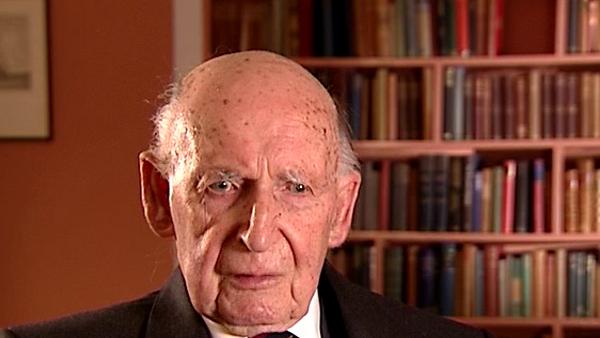NEXT STORY

More work on Venus and having to stop working with radar
RELATED STORIES

NEXT STORY

More work on Venus and having to stop working with radar
RELATED STORIES



On the radar aspects of the work, this continued for some time after the telescope came into use. I've already mentioned the work of JV Evans on the study of the Moon and unfortunately for us, Evans' work, we had frequent visitors from America and Evans attracted the attention of the Americans, was invited to America and for him, they spread out the red carpet and offered him such a vast salary that we could not possibly hope to retain him. So he disappeared into the American network and, in fact, became... became head of the COMSAT organisation. I'm afraid I... I eventually have lost touch with him, so I... I can't... history, but he passed out of research into the industrial world, world of America, and became highly placed director of one of the communication networks.
I was then left with other people who... Ponsonby and Thompson, who... alas is no longer living, and I interested them in attempting the radar detection of the planet, Venus. Now, this was a matter of considerable importance because the, the distance of Venus, the parallax of Venus was not precisely known. There had been enormous arguments about this and... and particularly about the rotation of Venus. You must remember that Venus is cloud-covered and is impossible to observe even with the most powerful telescopes, any of the surface features. So the problem of Venus had always interested me because I had grown up in the belief from some people that Venus, although cloud-covered, the clouds were like we have on Earth and therefore Venus was an abundant field for life and vegetation since the clouds must be like our own rain clouds. And there are others who argue that this is not the case. It must be an arid desert.
Well, there was also the problem about the distance of Venus and its parallax and about its rate of rotation and it's mode of rotation. For the pulse radar... the detecting Venus by radar became of considerable astronomical importance, and when Evans left Jodrell, I interested Ponsonby and Thompson on developing the system for the radar work on Venus. This required quite a powerful transmitter and I found that the nuclear physicists in the university, in the physics department, were ready to... to give me a very... very powerful klystron working on the frequency of 408 megahertz, of which they no longer had any use. So we transported this klystron and mounted it at the top of one of the towers of the telescope, and this was the transmitter which we used on the... on the radar programme in the search for echoes from Venus.
Now, in the early 1960s, this... again, in the beginning required integration and... and the close approach of Venus. It was not an observation one could make at any time because that really only became most likely when Venus did one of its close approaches. This was eventually achieved and Ponsonby and Thompson obtained an accurate measurement for the distance of Venus, but alas, the Americans by that time, had... had also caught up and had almost simultaneously built an equipment with a very powerful transmitter, which had measured the... the distance of Venus.
Now, the extraordinary thing about this radar measurement, whilst it had differed from the... what was believed to be the accurate measurements of the optical measurements on the distance of Venus, there... there are various measurements made optically of the distance of Venus and... I can't remember the exact details now, but they were believed to be accurate and spread over about a tenth of percent of what was believed to be the case, but in fact it was wrong. The radar measurement was outside the optical spread of the... of the well-known optical limits and the radar measurement was quickly accepted by the International... by... by the International Astronomy Union as... and is now regarded as the valid distance for the planet Venus. This became of extreme importance, as I will mention in a moment, when the Russians began to attempt to send a rocket to Venus.
Bernard Lovell (1913-2012), British radio astronomer and founder of the Jodrell Bank Observatory, received an OBE in 1946 for his work on radar, and was knighted in 1961 for his contribution to the development of radio astronomy. He obtained a PhD in 1936 at the University of Bristol. His steerable radio telescope, which tracked Sputnik across the sky, is now named the Lovell telescope.
Title: JV Evans leaves for America and measuring the distance of Venus
Listeners: Megan Argo Alastair Gunn
Megan Argo is an astronomer at the University of Manchester's Jodrell Bank Observatory researching supernovae and star formation in nearby starburst galaxies. As well as research, she is involved with events in the Observatory's Visitor Centre explaining both astronomy and the history of the Observatory to the public.
Alastair Gunn is an astrophysicist at Jodrell Bank Observatory, University of Manchester. He is responsible for the coordination and execution of international radio astronomical observations at the institute and his professional research concerns the extended atmospheres of highly active binary stars. Alastair has a deep interest and knowledge of the history of radio astronomy in general and of Jodrell Bank in particular. He has written extensively about Jodrell Bank's history.
Tags: USA, Venus, Jodrell Bank, International Astronomy Union, J V Evans, J H Thompson, J E B Ponsonby
Duration: 6 minutes, 7 seconds
Date story recorded: January 2007
Date story went live: 05 September 2008